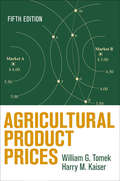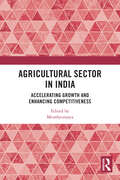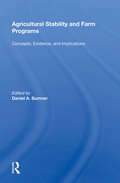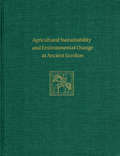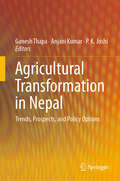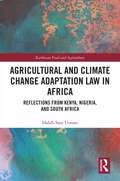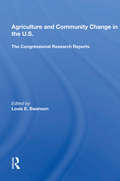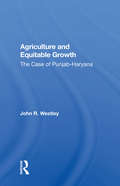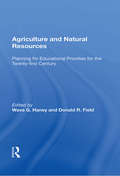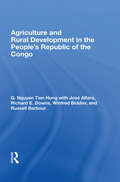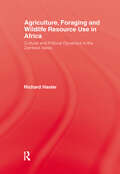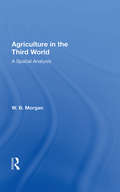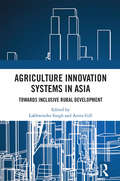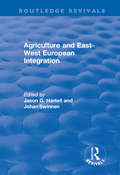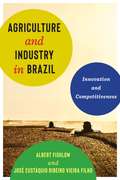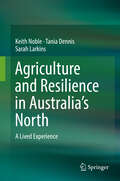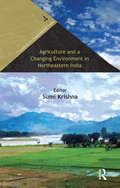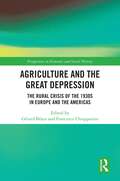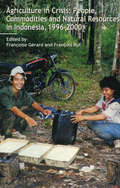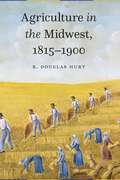- Table View
- List View
Agricultural Product Prices
by Harry M. Kaiser William G. TomekPublished continuously since 1972, Agricultural Product Prices has become the standard textbook and reference work for students in agricultural and applied economics, buyers and sellers of commodities, and policymakers, clearly explaining conceptual and empirical models applicable to agricultural product markets. The new fifth edition uses up-to-date information and models to explain the behavior of agricultural product prices. Topics include price differences over market levels (marketing margins), price differences over space (regionally and internationally) and by quality attributes, and price variability with the passage of time (seasonal and cyclical variations, trends, and random behavior). William G. Tomek and Harry M. Kaiser review and adapt microeconomic principles to the characteristics of agricultural commodity markets and then apply these principles to the various dimensions of price behavior. They also provide an in-depth discussion of prices established for futures contracts and their relationship to cash (spot) market prices; cover the influential roles of price discovery institutions, such as auctions and negotiated contracts, and government policies regulating trade and farms; and discuss the specification, use, and evaluation of empirical models of agricultural prices, placing emphasis on the challenges of doing high-quality, useful analyses and interpreting results.
Agricultural Sector in India: Accelerating Growth and Enhancing Competitiveness
by MruthyunjayaThis book presents a comprehensive overview of a range of concepts, methods, strategies and policies in agriculture and natural resource management, environmental economics, production economics and sustainable agricultural development. It explores effective analytical tools and science, innovations, and management solutions to enhance yields, manage the supply chain, strengthen institutional mechanisms, and service and support systems for farmers. It highlights the importance of enabling policies which can benefit farmers, resulting in cost-efficient and quality-improving farm practices, increased profits and income for farmers, and better management of natural resources. The essays in the book honour the academic, teaching, and research contributions of Professor R. Ramanna in the field of agricultural economics. They also address issues which are relevant to the growing research in sustainable agricultural development and natural resource management including the use of new concepts, tools, analyses, technologies, innovations, and policy strategies modelled in local contexts that can easily be scaled and applied to similar contexts elsewhere. This book will be of interest and use to students, researchers, practitioners,and policymakers working in varied fields of agricultural economics, sustainable development, public policy, rural sociology, political economy, economics of innovation, institutional economics, and industrial organisation.
Agricultural Stability And Farm Programs: Concepts, Evidence, And Implications
by Daniel A. SumnerThis book attempts to contribute to a fuller understanding of perennial issues underlying farm problems and agricultural policies in the United States thus contributing to better projections of policy effects, to better forecasts of policy changes, and perhaps to better policy for agriculture.
Agricultural Sustainability and Environmental Change at Ancient Gordion: Gordion Special Studies 8
by John M. MarstonThis book publishes the results of 220 botanical samples from the 1993-2002 Gordion excavations directed by Mary Voigt. Together with Naomi Miller's 2010 volume (Gordion Special Studies 5), this book completes the publication of botanical samples from Voigt's excavations. The book aims to reconstruct agricultural decision making using archaeological and paleoenvironmental data from Gordion to describe environmental and agricultural changes at the site.John M. Marston argues that different political and economic systems implemented over time at Gordion resulted in patterns of agricultural decision making that were well adapted to the social setting of farmers in each period, but that these practices had divergent environmental impacts, with some regimes sponsoring sustainable agricultural practices and others leading to significant environmental change. The implications of this book are twofold: Gordion will now be one of the best published agricultural datasets from the entire Near East and, thus, serve as a valuable comparable dataset for regional synthesis of agricultural and environmental change, and the methods the author developed to reconstruct agricultural change at Gordion serves as tools to engage questions about the relationship between social and environmental change at sites worldwide. Other books address similar themes but none in the Near East address these themes in diachronic perspective such as we have at Gordion.University Museum Monograph, 145
Agricultural Transformation in Nepal: Trends, Prospects, and Policy Options
by P. K. Joshi Ganesh Thapa Anjani KumarThis book addresses some key strategic questions related to agriculture in the context of major contemporary developments and emerging challenges in Nepal such as the changing role of agriculture with economic growth, structural transformation in reducing poverty, improving nutritional outcomes, and addressing the challenges of climate change. The book also suggests policy measures to improve the delivery of critical inputs and services and ensure the participation of marginal and smallholders in high-value chains. Further, it discusses how the new federal system and governance structure will affect the delivery of agricultural technology and services. The book is divided into five parts. Part I discusses macro-issues in the agriculture sector, while Part II focuses on agricultural productivity growth and its main drivers. The third part explores diversification in the agricultural and non-agricultural sectors by farmers and other rural people for livelihood improvement, while the fourth part deals with agricultural trade and marketing issues, highlighting policy implications and recommendations in the areas of immediate focus and further research. Lastly, Part V addresses institutions and governance issues, which are vital for agricultural development. In the final chapter, the editors summarize and synthesize the book’s main findings and develop a policy agenda for addressing the many challenges faced by the agriculture sector in Nepal, so as to make it more productive, competitive, sustainable, and inclusive. The book offers a rich source of analytical information on various aspects of agricultural development in Nepal and will be of immense value to policymakers, development partners, civil society, students, and those interested in the economic and agricultural development of not only Nepal, but also other developing countries.
Agricultural and Climate Change Adaptation Law in Africa: Reflections from Kenya, Nigeria, and South Africa (Earthscan Food and Agriculture)
by Habib Sani UsmanThis book presents an analysis of climate change and agricultural laws in Kenya, Nigeria, and South Africa in order to determine whether they adequately addressed the concept of agricultural adaptation.Agriculture is one of the sectors of the economy that is contributing to climate change, and at the same time the sector is heavily impacted by climate change. Therefore agricultural adaptation is required. Focusing on three countries, this book provides a novel, comparative examination of how and to what extent the law promotes agriculture-focused adaptation in these countries. The role of the law in addressing issues such as water management strategies, soil conservation methods, and crop production methods is discussed. This book identifies gaps in the regulatory frameworks for agricultural adaptation and highlights the lack of adaptive capacity of African agriculture due to weak or non-existing legal frameworks. It discusses ways to remedy these gaps through specific on-farm adaptation strategies, legislative amendments to consolidate all relevant national climate change-related policies and laws with agricultural policies and laws that have relevant provisions on adaptation as medium-term solutions, and the development of a specific framework law for agriculture-focused adaptation, incorporating essential agricultural adaptation strategies, could perhaps be enacted as long-term solutions to the regulatory gaps.This book will be of great interest to students and scholars of law, climate change, food and agriculture, sustainable development, and African studies.
Agriculture And Community Change In The U.s.: The Congressional Research Reports
by Louis E. SwansonThis book contains the Office of Technology Assessment commissioned papers analyzing the Northeast, South, Midwest, the Great Plains and the West of the U.S. The papers indicate that the relationship between the structure of agriculture and characteristics of rural communities vary in the U.S. .
Agriculture And Employment In Developing Countries: Strategies For Effective Rural Development
by Bela B MukhotiHigh rates of growth in agricultural production need not be incompatible with increased employment, income, and the satisfaction of basic needs in the lower-income developing countries. Emphasizing this theme, the author presents three alternative agricultural development strategies and suggests guidelines for identifying appropriate policies and p
Agriculture And Equitable Growth: The Case Of Punjab-haryana
by John R. WestleyThis book aims to examine how the pattern of growth in the agricultural sectors has contributed to equitable growth and to assess the relevance of the relationship between agriculture and equitable growth in Punjab-Haryana for other states in India and for other low-income countries.
Agriculture And Natural Resources: Planning For Educational Priorities For The Twenty-first Century
by Donald R. Field Wava G. HaneyThis book identifies issues and trends in agriculture, natural resources, and rural communities in the context of topical strategic planning. It portrays both the process of planning and the substantive content driving a planning process. .
Agriculture And Rural Development In The People's Republic Of The Congo
by G. Nguyen HungThis comprehensive study outlines the current transformation in agriculture and its effect on the demography, development, and economy of the People’s Republic of the Congo. G. Nguyen Tien Hung analyzes fundamental structural changes within the economy and the impact of the application of the Marxist model of development upon the performance and gr
Agriculture Foraging & Wildlife
by HaslerFirst Published in 1996. Routledge is an imprint of Taylor & Francis, an informa company.
Agriculture Geography First Semester FYBA, B.COM, B.SC New NEP Syllabus - SPPU
by Dr Jyotiram C. More Prof. Harishchandra S. Timbole Dr Ganesh Madhukar DhawaleThe book titled "Agriculture Geography" provides a comprehensive overview of agricultural geography, its principles, and its importance. It begins with the definition and scope of agricultural geography, examining the spatial relationships between agriculture and human activities. The text discusses the various types of agriculture, including subsistence, commercial, and mixed farming, as well as modern trends like smart and natural farming. It explores the physical and economic factors influencing Indian agriculture, highlights the historical and geographical transformations in agricultural practices, and addresses the impact of agricultural revolutions like the Green, White, and Blue Revolutions. The book also covers government policies, technological advancements, and new perspectives aimed at achieving sustainable agriculture, ensuring food security, and improving farmer incomes. Designed as a textbook for students, it combines theoretical knowledge with practical insights, supported by exercises and examples for academic and competitive examinations.
Agriculture In Third Wrl/h
by W. B. Morgan... we do not yet seem to have realised that the exchange of products between countries in one part of the world but at different stages of development is no less natural, and no less profitable for the various nations, than the exchange of products which differ because they grow in different climates' (Thiinen-Hall, xg66, p. 194). There have been few attempts to study agriculture within a spatial framework, notwithstanding the quintessential importance of land as a production factor. Land is most often treated as generalized environment although it could also be considered as social and economic space-social because even the most crowded of farming communities has much greater distance between its basic social units than exist within an urban-industrial agglomeration, and economic because distances to markets, to factor sources and to information must be overcome and frequently vary by type of market, factor and information source. Modem agricultural geography has been largely preoccupied with the development of techniques and with classification, often as ends in thexnselves, or with a geographical element consisting mainly of some general locational reference or regional description. Rarely has there been an attempt to identify a spatial structure associated with some particular agricultural enterprise* or practice.
Agriculture Innovation Systems in Asia: Towards Inclusive Rural Development
by Lakhwinder Singh Anita GillThis book looks at agricultural systems and rural economies in Asia through the prism of alternative innovation systems, alternative public policy and institutional changes. The massive shifts within the agricultural economy in Asia, geared towards increasing production, has had a direct effect on the livelihood of a large mass of people in rural societies, causing financial and social distress. This book explores a wide range of solutions, such as the role of education, improving technical skills and human capital, along with interactive learning in R&D, harnessing ICTs and institutional innovations, to see how these problems can be alleviated. The volume looks at how these methods can help formulate alternative ways to build sustainable and inclusive agricultural societies, ensure food security, sustainable growth and agricultural productivity. This book, rich in theoretical and empirical matter, will be useful for academics and researchers interested in agricultural innovation, development studies and agricultural economics. It will also be of interest to policymakers and thinktanks working towards inclusive social development and sustainability in Asia and the Indian subcontinent.
Agriculture and East-west European Integration
by JASON G. HARTELL, JOHAN F.M. SWINNENThis title was first published in 2000: This volume analyzes key issues of the process of integrating Central and Eastern European countries with the European Union related to agriculture. The issues include the comparative advantage of CEEC agriculture and its development under various accession policy scenarios; the likely policy developments in both the CEECs and the EU, based on economic, social and political economy considerations; the expected economic impacts and adjustment costs for the agro-food sector under various policy outcomes; the most important constraints for integration including policy convergence issues and internal constraints; and how integration will potentially affect trade and labour flows in the Union. The country combines detailed country-specific and region-wide empirical and theoretical analysis.
Agriculture and Economic Development in East Asia: From Growth to Protectionism in Japan, Korea and Taiwan (Esrc Pacific Asia Ser.)
by Penelope Francks Joanna Boestel Choo Hyop KimA comparative study which describes and analyses the contribution of agriculture to the economies of East Asia. Until now, little attention has been paid to the agricultural sector which actually underpins industrial and commercial development. Recently, this sector has become the focus of increasingly bitter economic disputes, especially over protection and the use of import tariffs. A comparative framework is used, employing case studies from Japan, Taiwan and South Korea to highlight both the common characteristics of agriculture's role in East Asian development, and features particular to the political economy of agriculture in each country.
Agriculture and Industry in Brazil: Innovation and Competitiveness
by Albert Fishlow José Eustáquio Vieira FilhoAgriculture and Industry in Brazil is a study of the economics of Brazilian agriculture and industry, with a special focus on the importance of innovation to productivity growth. Albert Fishlow and José Eustáquio Ribeiro Vieira Filho examine technological change in Brazil, highlighting the role of public policy in building institutions and creating an innovation-oriented environment.Fishlow and Vieira Filho tackle the theme of innovation from various angles. They contrast the relationship between state involvement and the private sector in key parts of the Brazilian economy and compare agricultural expansion with growth in the oil and aviation sectors. Fishlow and Vieira Filho argue that modern agriculture is a knowledge-intensive industry and its success in Brazil stems from public institution building. They demonstrate how research has played a key role in productivity growth, showing how prudent innovation policies can leverage knowledge not only within a particular company but also across whole sectors of the economy. The book discusses whether and how Brazil can serve as a model for other middle-income countries eager to achieve higher growth and a more egalitarian distribution of income. An important contribution to comparative, international, and development economics, Agriculture and Industry in Brazil shows how the public success in agriculture became a prototype for advance elsewhere.
Agriculture and Resilience in Australia’s North: A Lived Experience
by Keith Noble Tania Dennis Sarah LarkinsThis book examines the mechanisms and strategies farmers in North Australia adopt to manage the setbacks and challenges they face. This social research is based on farmers’ experiences, but also draws on the author’s own experience after his tropical fruit farm was destroyed by two Category 5 cyclones in five years.Through historical analysis, the book compares historic and contemporary aspirations for northern development, and discusses the influence of the built environment on individuals as well as access to health and other social services.Exploring the implications of individual resilience strategies for policy development within the broader context of northern development and evolving environmental governance, the book also highlights the fact that this is occurring in a new geological epoch – the Anthropocene.The book will provide a unique perspective and understanding to government, individuals and industries interested in northern Australia and its relationship to the world
Agriculture and a Changing Environment in Northeastern India (Transition In Northeastern India Ser.)
by Sumi KrishnaIndia’s northeastern region, forged by a unique geological history and peopled by several waves of migration, is extraordinarily complex. Farming systems in the hills and the riverine plains are embedded in a heterogeneous environment, comprising forests, wetlands and fields, shaped over centuries by nature and people. Today, the environment and economy are undergoing rapid transformation, affecting peoples’ lives, livelihoods and methods of food production.The essays in this volume bring a multi-disciplinary perspective to critical aspects of the process of agricultural change, examine the gender dimensions of agriculture, and explore initiatives for sustainable livelihood and ecological conservation. Part I analyses the impact of policies and people’s own aspirations on the closely-intertwined ecology and economy of the region. Part II discusses the gender dynamics of farming, forestry and biodiversity in a socio-cultural context where women are primarily responsible for food production. Part III highlights some alternative farming interventions and community-based efforts for environmental conservation, sustainable resource management and improved livelihoods.This book will be useful to scholars and students of agriculture, economics, development, environment and gender studies, and to those involved in policy analysis, natural resource management and community organisation, as also general readers interested in India’s northeastern region.
Agriculture and the Confederacy
by R. Douglas HurtIn this comprehensive history, R. Douglas Hurt traces the decline and fall of agriculture in the Confederate States of America. The backbone of the southern economy, agriculture was a source of power that southerners believed would ensure their independence. But, season by season and year by year, Hurt convincingly shows how the disintegration of southern agriculture led to the decline of the Confederacy's military, economic, and political power. He examines regional variations in the Eastern and Western Confederacy, linking the fates of individual crops and different modes of farming and planting to the wider story. After a dismal harvest in late 1864, southerners--faced with hunger and privation throughout the region--ransacked farms in the Shenandoah Valley and pillaged plantations in the Carolinas and the Mississippi Delta, they finally realized that their agricultural power, and their government itself, had failed. Hurt shows how this ultimate lost harvest had repercussions that lasted well beyond the end of the Civil War.Assessing agriculture in its economic, political, social, and environmental contexts, Hurt sheds new light on the fate of the Confederacy from the optimism of secession to the reality of collapse.
Agriculture and the Great Depression: The Rural Crisis of the 1930s in Europe and the Americas (Perspectives in Economic and Social History)
by Gérard Béaur Francesco ChiapparinoWhat role did the agricultural sector play in the economic crash of 1929? Taking evidence from country cases across Europe and the Americas, this edited volume explores short-, medium- and long-term perspectives on the primary sector. The monograph brings together the voices of an international panel of contributors who examine issues such as falling prices, industrial production, unemployment and the stagnation of aggregate demand. Together, they frame the interwar period as a pivotal turning point in the decline of subsistence agriculture and the growth of agricultural subsidies, which remain a key policy tool in many economies today. This illuminating book will be of interest to advanced students and researchers in economic history, agricultural history, globalization, and economic development.
Agriculture in Crisis: People, Commodities and Natural Resources in Indonesia 1996-2001
by Francoise Gerard Francois RufIndonesia's monetary and political crisis is examined here in relation to its impact on Indonesia's agricultural sector. The twelve essays that comprise this volume take a micro-economic approach and analysis relies on observed facts and first-hand data collected both before and after the country's crisis. This is a lively, well illustrated and instructive book.
Agriculture in the Midwest, 1815–1900
by Prof. R. Douglas HurtAfter the War of 1812 and the removal of the region&’s Indigenous peoples, the American Midwest became a paradoxical land for settlers. Even as many settlers found that the region provided the bountiful life of their dreams, others found disappointment, even failure—and still others suffered social and racial prejudice. In this broad and authoritative survey of midwestern agriculture from the War of 1812 to the turn of the twentieth century, R. Douglas Hurt contends that this region proved to be the country&’s garden spot and the nation&’s heart of agricultural production. During these eighty-five years the region transformed from a sparsely settled area to the home of large industrial and commercial cities, including Chicago, Milwaukee, Cleveland, and Detroit. Still, it remained primarily an agricultural region that promised a better life for many of the people who acquired land, raised crops and livestock, provided for their families, adopted new technologies, and sought political reform to benefit their economic interests. Focusing on the history of midwestern agriculture during wartime, utopian isolation, and colonization as well as political unrest, Hurt contextualizes myriad facets of the region&’s past to show how agricultural life developed for midwestern farmers—and to reflect on what that meant for the region and nation.
Agriculture, Environment and Development: International Perspectives on Water, Land and Politics
by Antonio Augusto Rossotto Ioris Bernardo Mançano FernandesThe Second Edition of this book is completely revised and updated throughout providing an overview of current challenges faced within the area of Agri-food in relation to policymaking, ecological conservation and socio-environmental justice. Including a range of new chapters, the book explores some of the conceptual and analytical gaps that are presented by current approaches to this topic. The series of interconnected chapters offers a critical reinterpretation of the tensions associated with the failures of mainstream regulatory regimes, land and resource grabbing, and the impacts of global agri-food chains at local, regional and inter-sectoral scales. The book also examines past legacies and emerging challenges associated with agriculture modernisation, politico-spatial disputes, climate change, social movements, gender, ethnicity and education. It likewise addresses the transformative potential of different combinations of biophysical, socio-technical and socio-spatial practices of food sovereignty.
